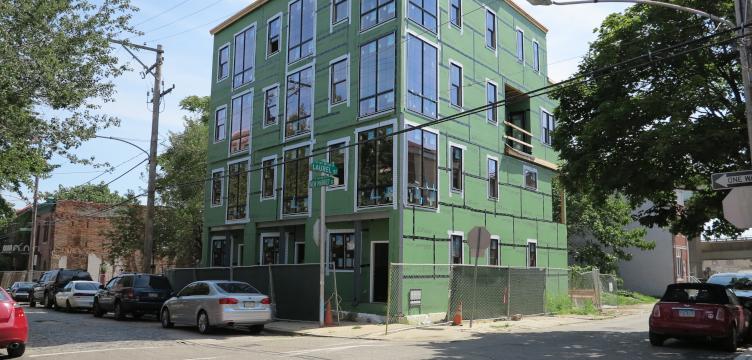Changes to plumbing code expected to sharply reduce Philly construction costs
Cheaper and more environmentally-friendly plastic infrastructure is now the norm.

The cost of residential construction is high in Philadelphia, the fourth most expensive building market in the U.S. (Ashley Hahn/Eyes On The Street)
This story originally appeared on PlanPhilly.
—
Of the fifty largest cities in America, only Philadelphia and six other union-friendly urban centers still require the use of expensive, heavy metal pipes in high-rise residential construction.
Cheaper and more environmentally-friendly plastic infrastructure is now the norm for builders installing pipes for waste disposal, fresh water, and stormwater drainage in most places.
Now after months of negotiation between the key interest groups — residential builders and the plumbers union — there’s been a breakthrough for Mayor Jim Kenney’s attempt to update the city’s plumbing code to allow for more extensive use of plastic pipes.
“If I had to ballpark it, I’d say the overall cost reductions [for applicable projects] would be 20 percent,” said Jim Maransky, president of the Building Industry Association, during a speech at the group’s annual conference.. “But it would be a 50 percent decline in costs for materials and the amount of labor is probably equal.”
The two groups negotiated under the aegis of Kenney’s Plumbing Advisory Board, which held its first, and only, public meeting in February. With facilitation from the Department of Licenses and Inspections (L&I), this summer they drafted a memorandum of understanding (MOU) that will be incorporated into the administration’s new building code next year.
“We expanded use of plastic pipe, that’s huge for builders,” said Maransky. “The plumbers union and the BIA worked together… [to bring] plumbing into the 20th century.”
Under Philadelphia’s current plumbing code, plastic piping can only be used in residential buildings of three stories or less (or in buildings with four or fewer dwelling units). The MOU would change that to allow the cheaper, plastic pipes in residential buildings of up to 75 feet in height, meaning five to six stories. (If a building includes a commercial use, like first floor retail, it would still require metal pipes in that area, but not the residential parts of the building.)
The MOU would also allow some plastic piping in high-rise residential buildings up to 150 feet. In these cases, metal pipes would still be required outside individual housing units, but plastic piping would be allowed within those apartments or condos.
Currently, the existing code encourages the construction of smaller single-family homes, which don’t require metal piping, or expensive luxury towers that can offset higher construction costs with steeper prices.
Walt Kryzanowski, who negotiated on behalf of the union, said that this code revision will change that calculation.
“It will definitely encourage residential high-rise and mid-rise dwellings,” said Kryzanowski, who is president of the Plumbing Contractors – Union Affiliated Contractors of Plumbers Union Local 690.
According to a 2017 report from the BIA, the other cities that still require metal piping in residential high-rise construction include San Francisco, New York, Chicago, Boston, and Washington D.C. (Omaha, Ne. also employs more rigorous iron piping requirements, although they aren’t as stringent as the regulations in the other six cities.)
All of these cities also have strong building trades union movements, although the profits for developers are also greater in cities like New York and San Francisco.
In a February interview with PlanPhilly, Kevin Gillen — who often consults with the BIA — said that the heavier and more unwieldy metal pipes are favored by plumbers’ unions in part because they generate more work hours for the membership.
“A common saying in the industry is that it takes ten men to carry one length of cast iron pipe, but only one man to carry ten lengths of PVC pipe,” said Gillen, a senior research fellow with Drexel University’s Lindy Institute for Urban Innovation.
Kryzanowski disagrees with such characterizations. Thinking about the reform in terms of work hours for union members is simply the wrong frame, he said.
“Work hours are not a consideration here,” said Kryzanowski. “When we talk about updating the plumbing code it’s about what’s right for the city of Philadelphia and the residents and for bringing new people and new construction into the city.”
The plumbers’ union and the BIA were the principal interest groups who weighed in on the plumbing code revision, but they weren’t the only ones. Pipe suppliers sided with the union — iron piping is more profitable — and environmental building groups sided with the industry, because plastic pipes leak less and are less detrimental to manufacture.
The MOU between the union and industry is only the first step. Once the Plumbing Advisory Board’s work is officially completed, it will have to be reviewed by L&I (which organized the reform effort), the state’s Department of Labor and Industry, and City Council.
Reached for comment, L&I issued a measured statement about the MOU.
“L&I is thrilled that the Board has made significant progress and we are excited by the work that has been completed to date,” said Karen Guss, media representative for L&I, in an email message. “We will not have any additional comment until the Board presents its final draft to the Commissioner for his review.”
—
Read the MOU between the Building Industry Association and the Plumbers’ Union.
WHYY is your source for fact-based, in-depth journalism and information. As a nonprofit organization, we rely on financial support from readers like you. Please give today.







